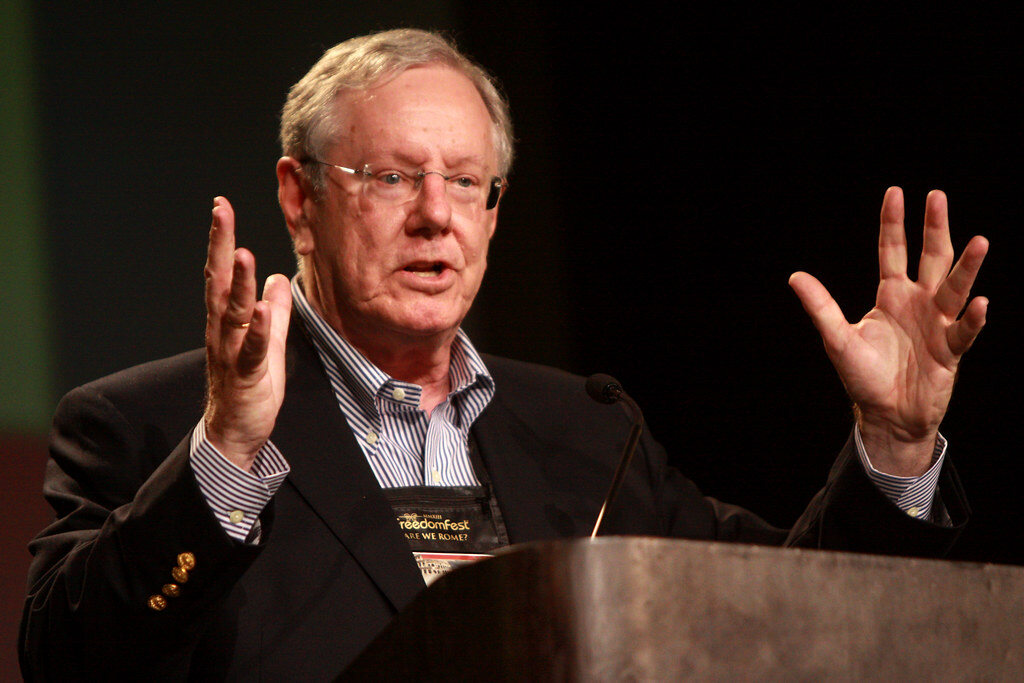Slashing red tape and eliminating loopholes how a 15% flat tax could reshape the US economy
What to Know:
- Forbes and Moore propose a universal 15% tax rate, eliminating deductions for individuals and corporations.
- Americans spend 8 billion hours filing taxes, costing the economy $546 billion in lost productivity.
- Eliminating the SALT deduction could save $2 trillion, reducing tax benefits for high-income earners.
- Past tax cuts, including the 2017 TCJA and Reagan-era cuts, increased revenue despite lower rates.
- Trump supports a 15% corporate tax, but GOP divisions on deductions like SALT could derail the plan.
In a recent Wall Street Journal op-ed, economic policy experts Steve Forbes and Stephen Moore put forward a bold proposal: a 15% flat tax for both individuals and corporations. Their argument is simple—scrap the labyrinth of deductions and loopholes, collapse tax brackets into a single rate, and create a system that is fairer, more transparent, and more conducive to economic growth.
When Donald Trump passed the Tax Cuts and Jobs Act (TCJA) in 2017, it was hailed as a game-changing economic reform. Now, some of the same voices that helped craft that policy—including Steve Forbes and Stephen Moore—are urging him to go even further. If Trump embraces this policy in 2025, he has the opportunity to slash bureaucracy, drive economic expansion, and drain the swamp of tax-code manipulation once and for all.
The Cost of Tax Complexity
One of the most compelling reasons for tax reform is the sheer burden of compliance. Americans spend 8 billion hours filing taxes every year, and this inefficiency costs the economy $546 billion in lost productivity and expenses. That’s half a trillion dollars that could be reinvested into businesses, wages, and innovation.
The 2017 TCJA made a dent in this problem by doubling the standard deduction (from $12,500 to $25,000 for married couples) and reducing itemized deductions from 40% to just 9% of taxpayers. Now, Forbes and Moore argue that the next logical step is to eliminate remaining deductions altogether and implement a uniform 15% tax rate.
Why a Flat 15% Tax?
When Donald Trump signed the Tax Cuts and Jobs Act (TCJA) in 2017, it reshaped the tax code, doubling the standard deduction and slashing corporate taxes. Now, economic heavyweights Steve Forbes and Stephen Moore are pushing for an even bolder step: a flat 15% tax rate for individuals and corporations. They argue that it would fuel growth, cut bureaucratic waste, and eliminate the loopholes that let special interests game the system.
Their vision is simple—no more complex deductions, no more special carve-outs, just a flat, low tax rate that applies to everyone, from small businesses to Fortune 500 CEOs. The result? A flood of capital into the U.S. economy, more take-home pay for workers, and an IRS stripped of its sprawling bureaucracy. It’s a vision rooted in economic efficiency, but one that also comes with significant political challenges.
Cutting the Loopholes That Benefit the Wealthy
For this plan to work, the current tax system’s most protected deductions would have to go. The mortgage interest deduction, once a sacred cow for homeowners, is already fading—only 9% of taxpayers still use it. The state and local tax (SALT) deduction, which overwhelmingly benefits high-income earners in blue states, is a prime target. The Tax Foundation estimates eliminating SALT would generate $2 trillion over the next decade, an amount that could offset revenue losses from cutting rates.
Then there’s the charitable contributions deduction. Critics argue that removing it would hurt nonprofits, but history suggests otherwise. When Reagan cut top tax rates from 70% to 28% in the 1980s, charitable giving surged to record levels. Moore and Forbes also take aim at corporate tax perks, particularly green energy subsidies, which they blame for crippling Germany’s industrial sector by driving up energy costs.
The logic is straightforward: The wealthiest Americans already find ways to shield their money through legal loopholes. Eliminating deductions and applying a single, low tax rate would force everyone—billionaires included—to contribute fairly. A tax system free from exemptions levels the playing field, replacing backroom deals with a transparent, universal rate.
Does Cutting Taxes Actually Raise Revenue?
The biggest pushback against the flat tax is the assumption that it would drain government revenue. Yet time and again, history suggests the opposite. The 2017 tax cuts didn’t reduce revenue—they increased it. After slashing corporate taxes, the economy expanded, jobs surged, and total tax receipts rose. Similar patterns emerged under Reagan, when lower rates led to an investment boom, wage growth, and higher overall tax payments.
The principle is simple: When the economy grows, tax revenue naturally increases. A low, predictable rate encourages businesses to invest and hire rather than hoard cash or exploit loopholes. If a 15% tax truly supercharges the economy, as Forbes and Moore predict, it’s possible that federal revenue wouldn’t shrink but instead rise, fueled by growth rather than bureaucratic micromanagement.
Trump’s Tax Legacy—Will He Take the Leap?
Trump has already floated a 15% corporate tax rate, suggesting he’s open to at least part of the plan. But whether he embraces the full flat tax depends on political realities. Republicans are split. Some want to raise the SALT cap instead of eliminating it, fearing backlash from middle-class homeowners in high-tax states. Lobbyists, from real estate to environmental groups, will fight to preserve their industry’s tax perks.
The challenge for Trump and his allies is to sell the flat tax as a populist, pro-worker reform—one that benefits middle-class families, not just corporations. If they can frame it as a crackdown on special-interest tax dodging, the policy could gain traction. But if it’s dismissed as a gift to the wealthy, even a Republican-controlled Congress might balk.
Forbes and Moore see this as a rare opportunity to simplify the tax code, reduce inefficiencies, and encourage economic growth. The question is whether Trump and Congress will embrace this vision or if political and economic concerns will lead to a more cautious approach.
Wrap Up
The idea of a 15% flat tax represents a seismic shift in America’s economic policy, with proponents arguing it would eliminate corruption, fuel growth, and simplify the tax code. However, its success hinges on whether Trump and Congress can sell it as a populist reform rather than a giveaway to corporations. If enacted, it could reshape the nation’s economy—but only if political and economic realities don’t force a more watered-down compromise.



.png)
-1.png)
